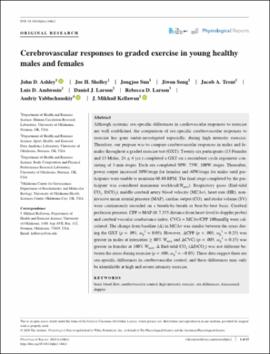| dc.contributor.author | Ashley, John D. | |
| dc.contributor.author | Shelley, Joe H. | |
| dc.contributor.author | Sun, Jongjoo | |
| dc.contributor.author | Song, Jiwon | |
| dc.contributor.author | Trent, Jacob A. | |
| dc.contributor.author | Ambrosio, Luis D. | |
| dc.contributor.author | Larson, Daniel J. | |
| dc.contributor.author | Larson, Rebecca D. | |
| dc.contributor.author | Yabluchanskiy, Andriy | |
| dc.contributor.author | Kellawan, J. Mikhail | |
| dc.date.accessioned | 2020-12-03T16:54:58Z | |
| dc.date.available | 2020-12-03T16:54:58Z | |
| dc.date.issued | 2020-10-28 | |
| dc.identifier.citation | Ashley, J.D., Shelley, J.H.., Sun, J., Song, J., Trent, J.A., Ambrosio, L.D., Larson, D.J., Larson, R.D., Yabluchanskiy, A. & Kellawan, J.M.. (2020). Cerebrovascular responses to graded exercise in young healthy males and females. Physiological Reports, 8(20). doi:10.14814/phy2.14622 | en_US |
| dc.identifier.uri | https://hdl.handle.net/11244/326575 | |
| dc.description.abstract | Although systemic sex‐specific differences in cardiovascular responses to exercise are well established, the comparison of sex‐specific cerebrovascular responses to exercise has gone under‐investigated especially, during high intensity exercise. Therefore, our purpose was to compare cerebrovascular responses in males and females throughout a graded exercise test (GXT). Twenty‐six participants (13 Females and 13 Males, 24 ± 4 yrs.) completed a GXT on a recumbent cycle ergometer consisting of 3‐min stages. Each sex completed 50W, 75W, 100W stages. Thereafter, power output increased 30W/stage for females and 40W/stage for males until participants were unable to maintain 60‐80 RPM. The final stage completed by the participant was considered maximum workload(Wmax). Respiratory gases (End‐tidal CO2, EtCO2), middle cerebral artery blood velocity (MCAv), heart rate (HR), non‐invasive mean arterial pressure (MAP), cardiac output (CO), and stroke volume (SV) were continuously recorded on a breath‐by‐breath or beat‐by‐beat basis. Cerebral perfusion pressure, CPP = MAP (0. 7,355 distance from heart‐level to doppler probe) and cerebral vascular conductance index, CVCi = MCAv/CPP 100mmHg were calculated. The change from baseline (Δ) in MCAv was similar between the sexes during the GXT (p = .091, ωp2 = 0.05). However, ΔCPP (p < .001, ωp2 = 0.25) was greater in males at intensities ≥ 80% Wmax and ΔCVCi (p = .005, ωp2 = 0.15) was greater in females at 100% Wmax. Δ End‐tidal CO2 (ΔEtCO2) was not different between the sexes during exercise (p = .606, ωp2 = −0.03). These data suggest there are sex‐specific differences in cerebrovascular control, and these differences may only be identifiable at high and severe intensity exercise. | en_US |
| dc.description.sponsorship | Open Access fees paid for in whole or in part by the University of Oklahoma Libraries. | en_US |
| dc.language | en_US | en_US |
| dc.rights | Attribution 4.0 International | * |
| dc.rights.uri | https://creativecommons.org/licenses/by/4.0/ | * |
| dc.subject | Brain blood flow | en_US |
| dc.subject | Cerebrovascular control | en_US |
| dc.subject | High-intensity exercise | en_US |
| dc.subject | Sex differences | en_US |
| dc.subject | Transcranial Doppler | en_US |
| dc.title | Cerebrovascular responses to graded exercise in young healthy males and females | en_US |
| dc.type | Article | en_US |
| dc.description.peerreview | Yes | en_US |
| dc.identifier.doi | 10.14814/phy2.14622 | en_US |
| ou.group | College of Arts and Sciences::Department of Health and Exercise Science | en_US |

